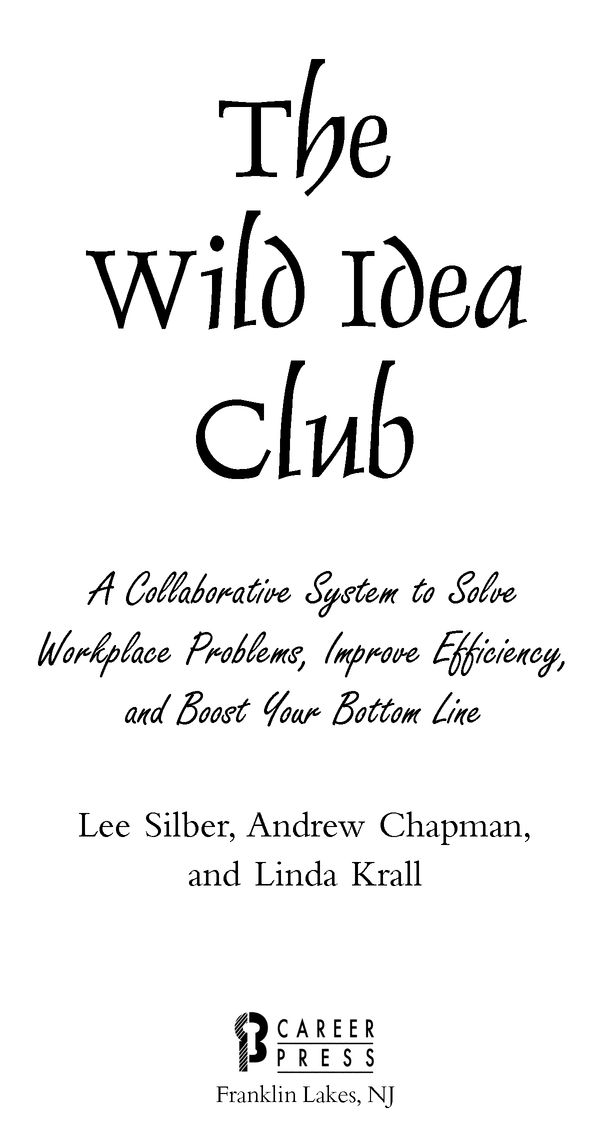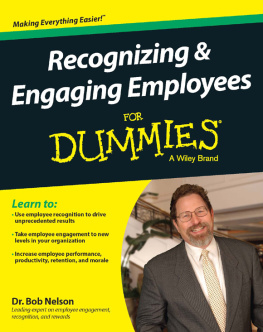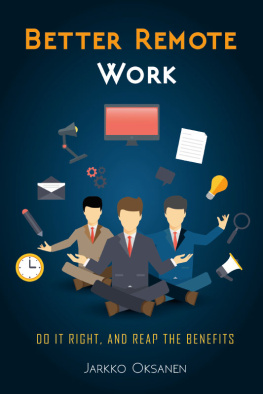Table of Contents

If at first the idea is not absurd,
then there is no hope for it.
Albert Einstein
Dedications
To Ethan and Evan, my two young sons who have wild ideas every day about everything, and yes, we have started our own Wild Idea Club.
Lee
To my parents and sister, whove always encouraged and supported my ideas, no matter how crazy they seemed.
Andrew
To my family, who always supports my entrepreneurial pursuits and creative ideas no matter how wild they are!
Linda
Acknowledgments
Behind every big thinker are people who take their wild ideas and turn them into something tangible. For more than 20 years, that person has been my wife, Andrea. (Im the big-picture person, and she deals with the details.) For the past 10 years, Toni Lopopolo has been able to decipher my scribbles and doodles and turn them into book deals; thank you, Toni. I must give a big high-five to my friend Doug Vance, who listened to me explain my idea for this book a couple of years ago and coined the phrase Wild Idea Club. Good call, Doug. Finally, for the past several months, the people at Career Press have been fantastic. Without their support this book wouldnt exist.
Lee
Thank you, Toni, for landing this book deal in a tough market. My appreciation also goes to Career Press for believing in the wild idea that became this book. Many thanks to Lee and Linda for our Wild Idea Club. And lastly, a big thank-you to all the teachers Ive had in my life, from preschool to college, because Im grateful for you more than you know.
Andrew
To Lee and Andrew, thank you for inviting me to on this journey with you; your talents amaze me. To Erika Kotite, Chris Pitchess, and Janine McDonald, words cant express how grateful I am for your friendship and mentoring; your insights and ideas are priceless! To Neal and my circle of friends, thank you for being such great cheerleaders. To my clients, thank you for the incredible experiences and learnings; you are some of the most innovative and creative people in the world.
Linda
Introduction
Whats the Big Idea?
Great discoveries and improvements invariably involve the cooperation of many minds. I may be given credit for having blazed the trail, but when I look at the subsequent developments I feel the credit is due to others rather than myself.
Alexander Graham Bell
The definition of a Wild Idea Club differs depending on which group you ask. If you ask managers, they will tell you its an extremely effective tool to encourage and enable employees to focus on solutions: When a Wild Idea Club is formed around a project or a problem (or just to generate more ideas), the members are employees drawn from different departments to work together to share their ideas and insights to solve workplace challenges, improve efficiency, and boost the bottom line of the business. The members think through their ideas and bring forward only the best ones with a practiced pitch and plan to make them possible. Its a managers dream come true: With minimal effort, employees begin harnessing their collective creativity and skills on their own for the betterment of all.
If you ask employees, they will tell you the Wild Idea Club concept is a Godsend. Finally, someone is interested in their ideas (and they have plenty of really good ones), and they now have an organized and efficient way to bring them forwardand have them taken seriously. These same people now feel less like employees and more like entrepreneurs. They take the success of the company more seriously now that they have a hand in helping make it better. In short, they are engaged (and excited) about being a part of the process of improving the workplace and making the company more profitable.
No matter whom you ask (employees or employers), the bottom line is that forming a Wild Idea Club in your company is good for the bottom line. Its also good for things that dont show up on a balance sheet (employee retention and satisfaction, just to name two). Wild Idea Clubs can be started by as few as four people or as many as two dozen (although 15 is a more practical limit). The club meetings can last as long as two hours, but are best when kept to under an hour, once or twice a month. And they can be done in person, on the phone, or online.
By following the guidelines and examples set forth in this book, a manager will have very little to dobut will gain a great deal when the club pitches their ideas in a professional and polished manner, focusing on practicality and a plan. Giving your employees your blessing to form a Wild Idea Club is truly a win-win proposition.
The collective genius of a group is a powerful thingwhen harnessed. In fact, studies have proven that organizations made up of teams outperform traditional bureaucracies. In many progressive companies such as Toyota,Southwest Airlines,Craigslist, YouTube, and Apple, the most important innovations come out of small groups, and account for a large percentage of the profits. Thats where the Wild Idea Club comes in. Its all about helping employees and employers discover the amazing results this concept can create in the workplace. And because it is based on universal principles of human creativity and organizational thinking, it will work regardless of the occupation, organization, or industry.
Tapping into employee creativity requires a system. Brainstorming sessions and meetings that go nowhere, get bogged down in details, or lack follow-through are immediately improved by the implementation of a Wild Idea Cluband this book outlines exactly how to start and maintain one (or more). The manager who taps into his or her peoples creativity by fostering a collaborative atmosphere will be rewarded with real results. Businesses that take advantage of this mastermind principle will see dramatic improvements in sales, service, and overall success. This is the edge companies need to thrive in the current (highly competitive) business climate.
Many companiesand the people who run thembelieve the best ideas come from the top. Theres no doubt most managers and executives have the education, experience, and expertise to come up with big ideas. But its also true that the people in the middle and on the bottom of an organization often have a lot of great ideas to contributewhen allowed to. The landmark El Cortez Hotel (now condos) in San Diego was the first in the country with a scenic elevator that ran up and down the outside of the building, and the idea came from a janitor. Now more than ever, companies need new and workable ideas to survive and thrive. The power of the Wild Idea Club comes from managers harnessing the innate ingenuity and entrepreneurship of their employees.
If there is one constant in business it is this: There are always problems to be solved. Workers who offer viable solutions to problems rather than complain about them are an asset to their managers and the organization. The Wild Idea Club concept encourages solution-oriented thinking and initiative in people. It not only fosters new ideas that can propel a business forward, but is also extremely effective in tackling the common complaints within companies that never seem to get solvedone of the biggest benefits of this concept.
Ultimately, the purpose of this book is to help managers tap into their employees natural abilities, so that important and breakthrough ideas are no longer languishing in their workers heads. This approach to work-related problem-solving increases employee retention, because the office environment becomes fun and energized, and workers feel important. As a result they take greater pride in their work.






